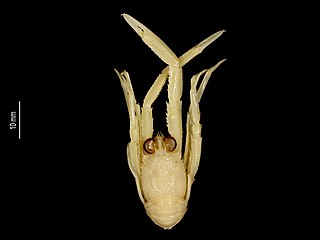
Squat lobsters are dorsoventrally flattened crustaceans with long tails held curled beneath the cephalothorax. They are found in the two superfamilies Galatheoidea and Chirostyloidea, which form part of the decapod infraorder Anomura, alongside groups including the hermit crabs and mole crabs. They are distributed worldwide in the oceans, and occur from near the surface to deep sea hydrothermal vents, with one species occupying caves above sea level. More than 900 species have been described, in around 60 genera. Some species form dense aggregations, either on the sea floor or in the water column, and a small number are commercially fished.

Anaspides is a genus of freshwater crustaceans in the family Anaspidesidae. The genus was first described in 1894 by George Malcolm Thomson. The genus was originally placed in the family, Anaspididae by Thomson, but this genus name was preoccupied by the insect genus, Anaspis Geoffroy, 1762, and therefore, in 2017, the family was renamed Anaspidesidae by Shane Ahyong and Miguel A. Alonso-Zarazaga.

Trapeziidae is a family of crabs, commonly known as coral crabs. All the species in the family are found in a close symbiosis with cnidarians. They are found across the Indo-Pacific, and can best be identified to the species level by the colour patterns they display. Members of the family Tetraliidae were previously included in the Trapeziidae, but the similarities between the taxa is the result of convergent evolution.
Anomoeomunida caribensis is a species of squat lobster in a monotypic genus in the family Munididae.

Plesionida is a genus of squat lobsters in the family Munididae. As of 2017, it contains the following species:
Setanida cristata is a species of squat lobster in a monotypic genus in the family Munididae.

Shinkaia crosnieri is a species of squat lobster in a monotypic genus in the family Munidopsidae. S. crosnieri lives in deep-sea hydrothermal vent ecosystems, living off of the chemosynthetic activity of certain bacteria living on its setae.

Neolithodes is a genus of king crabs, in the family Lithodidae. They are found in all major oceans, both in high and low latitudes. Although there are records from water as shallow as 124 m (407 ft) in cold regions, most records are much deeper, typically 700–2,000 m (2,300–6,600 ft), with the deepest confirmed at 5,238 m (17,185 ft). They are fairly large to large crabs that typically are reddish in color and spiny, although the size of these spines varies depending on species.
Agononida procera is a species of squat lobster in the family Munididae, and was first described by Shane Ahyong and Gary Poore in 2004. The specific name is derived from procerus, a Latin word meaning "slender", which is in reference to its slender cheliped that distinguish it from the similar Agononida soelae. The females measure from 14.3 to 21.4 millimetres. It is found off of Eastern Australia and New Caledonia and near the Lord Howe Rise, where it is found at depths from 450 to 960 metres.

Munida chydaea is a species of squat lobster in the family Munididae. It was first described in 2004 by Shane Ahyong and Gary Poore.The species name is derived from the Greek χυδαῖος, "abundant", in reference to how numerous the species is. The males measure between about 23.3 and 46.7 millimetres and the females between about 12.4 and 36.0 millimetres. It is found off of Tasmania and Victoria to Sydney, and in the Great Australian Bight, at depths between about 145 and 700 metres.
Munida aequalis is a species of squat lobster in the family Munididae. It was first described in 2004 by Shane Ahyong and GartyPoore.The species name is derived from the Latin aequalis, meaning "like" or "same", referring to the similar size of the terminal spines of the basal antennular segment. It is found northwest of Tweed Heads, New South Wales to near Wooli, New South Wales, at depths between about 150 and 550 metres. The males are usually between 14.0 and 41.5 millimetres long, with the females being between about 19.1 and 28.5 millimetres long.

Acanthosquilla derijardi is a species of stomatopod crustacean. Its distribution is widespread throughout the Indo-West Pacific. The species was initially described by the American carcinologist Raymond B. Manning in 1970. Its junior synonym, A. sirindhorn, was named in 1995 in honor of Princess Sirindhorn of Thailand.
Neolithodes flindersi is a species of king crab found in southeastern Australia. They have been found at depths of 887–1,333 metres (2,910–4,373 ft) but typically appear from 950–1,050 metres (3,120–3,440 ft). They most closely resemble Neolithodes brodiei and Neolithodes nipponensis.
Neolithodes yaldwyni is a species of king crab which is found in the Ross Sea from depths of 124–1,950 metres (407–6,398 ft). It had previously been misidentified as Neolithodes brodiei, and it closely resembles Neolithodes capensis.
Neolithodes nipponensis is a species of king crab which is found in Japan and Taiwan. It has been found at depths from 200–1,752 metres (656–5,748 ft).
Miyakella is a genus of shrimps belonging to the family Squillidae. It is a replacement name for Miyakea Manning, 1995 which was pre-occupied.
Shane Timothy Ahyong is an Australian zoologist specialising in marine invertebrates. Since 2010 he has worked as a senior principal research scientist at the Australian Museum. Following his Ph.D. he worked as a post-doctoral researcher at the Australian Museum and in 2006 left to manage Marine Biodiversity and Biosecurity Group and Marine Invasives Taxonomic Service within the National Institute of Water and Atmospheric Research in New Zealand.
Alima pacifica is a species of shrimp in the Squillidae family, and was first described in 2001 by Shane Ahyong.
Athanas sydneyensis is a species of small alpheid shrimp.
Alain raymondi is a species of crab in the Pinnotheridae family. It was first described in 2008 by Ahyong and Peter Ng. The species epithet, raymondi, honours Ray Manning.








